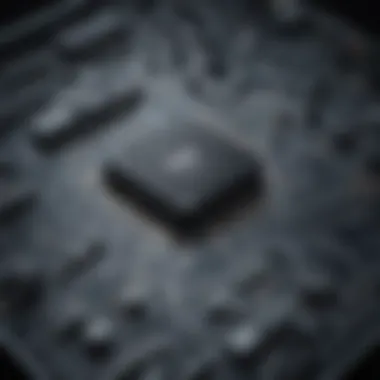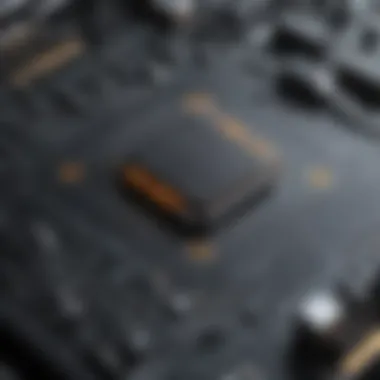Unlocking the Intricacies of Digital-to-Analog Converters: A Comprehensive Guide


Overview of Digital-to-Analog Converters (DACs)
In this section, we will embark on a detailed exploration of Digital-to-Analog Converters (DACs), delving into their intricate functionality, various types, applications, and the significant role they play in modern technology. We will unravel the complex process of converting digital signals into analog outputs, providing a thorough analysis of this fundamental aspect of electronic systems.
Fundamentals of DACs Explained
Diving deeper into the realm of DACs, we will discuss the core principles and theories that underpin the operation of these essential components. Key terminology and definitions related to DACs will be elucidated to enhance understanding, along with explanations of basic concepts and foundational knowledge necessary to grasp the intricacies of digital-to-analog conversion.
Practical Applications and Case Studies
This section will present real-world case studies and applications of DACs, offering insights into how these converters are utilized in various industries and products. Demonstrations and hands-on projects will be explored to provide a practical understanding of implementing DACs, including code snippets and implementation guidelines for those looking to experiment with these devices.
Advanced Developments and Trends in DAC Technology
Pioneering into the future of DAC technology, we will investigate cutting-edge developments in the field, including advanced techniques and methodologies driving innovations in digital-to-analog conversion. By exploring future prospects and upcoming trends, readers will gain valuable insights into the evolving landscape of DACs and the potential advancements that may shape the industry.
Tips and Resources for Further Learning
To enrich knowledge and foster continued learning, this final section will offer recommended books, courses, and online resources for those wishing to deepen their understanding of DACs. Additionally, tools and software essential for practical usage and experimentation with digital-to-analog converters will be highlighted, empowering readers to engage further with this fascinating area of technology.
Introduction to Digital-to-Analog Converters
Digital-to-Analog Converters (DACs) are fundamental components in modern technology that play a crucial role in converting digital signals into analog voltages. In this article, we will delve deep into the intricacies of DACs, exploring their significance and myriad applications across various industries. Understanding DACs is pivotal for grasping the essence of digital signal processing and ensuring signal accuracy and quality.
Definition of Digital-to-Analog Converters
What is a Digital-to-Analog Converter (DAC)?
A Digital-to-Analog Converter (DAC) is a pivotal electronic device designed to transform digital signals, expressed in binary code, into corresponding analog voltages or currents. The key characteristic of DACs lies in their ability to provide a continuous output voltage proportional to the digital input applied. This unique feature makes DACs widely favored in numerous applications where precise analog outputs are essential. Despite their effectiveness, DACs may encounter challenges regarding precision and noise, which require meticulous engineering to address.
How do DACs facilitate the conversion of digital signals to analog voltages?
DACs facilitate the conversion of digital signals to analog voltages through a process known as pulse-width modulation. By utilizing sampling techniques, DACs convert discrete digital values into continuous analog signals with utmost precision. The crux of DAC operation lies in accurately reconstructing the analog waveform from the sampled digital values, ensuring fidelity and stability in signal transmission. While DACs excel in maintaining signal integrity, variations in voltage reference and output fidelity can pose potential drawbacks that necessitate careful calibration and design considerations
Historical Evolution of DACs
The inception and development of DAC technology
The evolution of DAC technology traces back to the early days of computing, where analog interfaces were essential for interacting with the physical world. Over time, DACs have undergone significant advancements, transitioning from rudimentary resistor-based designs to sophisticated integrated circuits capable of high-speed and high-resolution conversions. The inception and development of DAC technology underscore the continuous innovation and improvement in digital signal processing, shaping the landscape of modern electronics.
Key milestones in the evolution of DACs


Key milestones in the evolution of DACs mark pivotal moments where technological breakthroughs revolutionized the functionality and efficiency of these devices. From the introduction of successive approximation ADCs to the integration of advanced DAC architectures in consumer electronics, each milestone represents a significant leap forward in enhancing the performance and versatility of DACs. These milestones serve as beacons of progress, illuminating the path towards more compact, efficient, and reliable DAC solutions for diverse applications.
Importance of DACs in Modern Technology
Applications of DACs in various industries
DACs find extensive applications across diverse industries, including telecommunications, audio processing, and industrial automation. In telecommunications, DACs play a crucial role in signal modulation and transmission, ensuring reliable data transfer and communication. Similarly, in audio processing systems, DACs enable faithful reproduction of sound, enriching the listening experience for consumers. The versatility of DACs transcends industry boundaries, making them indispensable components in modern technological landscapes.
How DACs contribute to enhancing signal accuracy and quality
The integration of DACs is paramount in enhancing signal accuracy and quality, paving the way for seamless data transmission and precise control systems. By leveraging advanced DAC architectures and precision engineering techniques, manufacturers can achieve unparalleled levels of signal integrity and resolution. Despite their remarkable contribution to signal enhancement, DACs require meticulous design considerations to mitigate noise and ensure consistent performance across varying operating conditions.
Types of Digital-to-Analog Converters
Digital-to-Analog Converters (DACs) play a pivotal role in converting digital signals into analog voltages with precision and accuracy. In this article, understanding the various types of DACs is essential to grasp their significance in modern technology. Different types of DACs offer unique benefits and considerations, such as Binary Weighted DACs, Sigma-Delta DAC architecture, and Differential Nonlinearity (DNL) in DACs. Each type contributes distinct advantages to the overall functionality of DACs, underscoring their importance in signal processing and conversion.
Classification based on Conversion Methods
The overview of Binary Weighted DACs:
The overview of Binary Weighted DACs signifies a fundamental approach in DAC technology. Its contribution lies in providing a simplistic yet effective method of digital-to-analog conversion. The key characteristic of Binary Weighted DACs is their linear relationship between digital input and analog output, making them a reliable choice for high-precision applications. The unique feature of Binary Weighted DACs is their scalability, allowing for customization based on resolution requirements. While they offer high accuracy, they may face challenges in matching resistor values accurately, impacting their overall precision.
Understanding the Sigma-Delta DAC architecture:
The Sigma-Delta DAC architecture is known for its ability to achieve high resolution and performance in digital-to-analog conversion. This architecture excels in reducing noise and distortion, enhancing signal quality significantly. The key characteristic of Sigma-Delta DACs is their oversampling technique, which amplifies resolution and accuracy. Their unique feature includes a delta-sigma modulator for noise shaping, reducing quantization errors effectively. While Sigma-Delta DACs offer superior audio quality and resolution, their complexity and higher power consumption can be potential drawbacks.
Differential Nonlinearity (DNL) in DACs:
Differential Nonlinearity (DNL) is a critical aspect of DAC performance, influencing the precision of analog output signals. DNL measures the deviation of actual step widths from the ideal value, affecting the overall accuracy of the conversion process. The key characteristic of DNL in DACs is its impact on signal linearity and distortion levels, crucial for maintaining signal integrity. The unique feature of DNL analysis is its ability to identify nonlinearities in the transfer function, aiding in calibrating and optimizing DAC performance. While DNL assessment is essential for ensuring accurate conversions, addressing DNL errors can be challenging and may require sophisticated calibration techniques.
Performance-related Classifications
Resolution and Accuracy in DACs:
Resolution and accuracy are paramount factors in DAC performance, determining the level of detail and precision in analog output signals. The high resolution allows for finer voltage increments, translating to enhanced signal fidelity. The key characteristic of resolution and accuracy in DACs is their direct correlation with signal quality, especially in audio reproduction and sensor applications. The unique feature of resolution enhancement techniques includes dynamic element matching and error correction algorithms, elevating DAC precision. While higher resolution leads to improved signal resolution, it can also result in increased complexity and higher power consumption.
Speed considerations in High-Speed DAC designs:
Speed considerations play a vital role in high-speed DAC designs, particularly in applications requiring rapid signal processing and transmission. The key characteristic of high-speed DACs is their ability to accommodate high-frequency signals with minimal latency, essential for real-time data conversion. The unique feature of speed-optimized DAC architectures includes advanced interpolation and clocking mechanisms, ensuring swift data conversion rates. While high-speed DACs excel in time-critical applications like telecommunications and radar systems, achieving both speed and accuracy can pose design challenges, influencing power consumption and circuit complexity.
Working Principles of Digital-to-Analog Converters


Digital-to-Analog Converters (DACs) operate on crucial principles that drive their functionality and efficacy. Understanding the workings of DACs is fundamental to grasp their role in modern technology. One paramount aspect is the accurate conversion of digital bits into analog voltages. It is pivotal as it enables the transformation of discrete digital signals into continuous analog waveforms necessary for various applications. This conversion process plays a vital role in signal accuracy and fidelity, showcasing the importance of precise digital input processing in DAC operations.
Another vital element in DAC operation is the incorporation of feedback mechanisms within DAC circuits. Feedback mechanisms play a pivotal role in ensuring the stability and precision of analog output signals. By providing a mechanism to compare the actual output with the desired one, feedback loops help in minimizing errors and enhancing the overall performance of DACs. Thus, understanding feedback mechanisms is crucial in comprehending how DACs maintain accuracy and consistency in signal reproduction.
Digital Input Processing
Conversion of digital bits into analog voltages
In the realm of Digital-to-Analog Converters, the conversion of digital bits into analog voltages is a critical process that underpins the functionality of DACs. This conversion mechanism involves translating binary digital inputs into proportional analog voltages. By employing techniques such as binary weighting or sigma-delta modulation, DACs can effectively generate precise analog outputs corresponding to the digital input values. The conversion of digital bits into analog voltages is a popular choice due to its versatility and applicability in diverse electronic systems, highlighting its significance in this article.
The unique feature of this conversion process lies in its ability to maintain linearity and accuracy in signal reproduction. By ensuring that each digital input bit corresponds accurately to its analog counterpart, DACs can faithfully reconstruct analog waveforms from digital data. However, challenges such as nonlinearity or quantization errors may influence the fidelity of the analog output, underscoring the importance of optimizing this conversion process for superior DAC performance.
Feedback mechanisms in DAC circuits
Feedback mechanisms within DAC circuits play a pivotal role in enhancing signal accuracy and stability. By incorporating feedback loops, DACs can compare the actual output with the desired output, enabling them to make real-time adjustments to minimize errors and discrepancies. This process ensures that DACs deliver precise and consistent analog signals, crucial for applications requiring high-fidelity audio or data reproduction.
A key characteristic of feedback mechanisms is their ability to regulate the output behavior of DACs, thereby reducing distortion and noise in analog signals. By continuously monitoring and adjusting the output based on feedback signals, DACs can mitigate errors and enhance overall signal quality. While feedback mechanisms contribute significantly to signal accuracy, they may introduce complexity and latency in DAC circuits, necessitating a balance between performance optimization and operational efficiency.
Analog Output Generation
Generation of continuous analog output signals
The generation of continuous analog output signals is a fundamental aspect of DAC operation, often achieved through precise voltage scaling mechanisms. By converting digital inputs into continuous analog waveforms, DACs can reproduce intricate signals with high fidelity and resolution. This generation process involves mapping digital values to specific voltage levels, ensuring that the analog output maintains the intended signal characteristics.
This aspect of DAC operation is essential for applications requiring smooth and uninterrupted analog signal generation. By enabling a seamless transition from digital data to analog waveforms, DACs facilitate accurate signal reproduction across various industries, ranging from audio processing to telecommunications. The continuous generation of analog output signals is a cornerstone of DAC functionality, marking its relevance and effectiveness in modern technological applications.
Filtering and smoothing of DAC output
After generating analog output signals, DACs often employ filtering and smoothing techniques to enhance signal quality and reduce noise artifacts. Filtering mechanisms help in eliminating unwanted frequency components or signal aberrations, ensuring that the output waveform remains clean and free from distortions. By smoothing out signal variations and irregularities, DACs can deliver stable and accurate analog outputs suitable for a wide range of applications.
The key characteristic of filtering and smoothing techniques is their ability to refine the analog output to meet specific requirements such as signal bandwidth or harmonic distortion levels. Through strategic signal processing algorithms, DACs can enhance the overall signal fidelity and clarity, optimizing signal quality for demanding applications. While filtering and smoothing techniques contribute to signal enhancement, they may introduce processing delays or complexities, necessitating careful consideration of trade-offs in DAC design and implementation.
Applications of Digital-to-Analog Converters
Digital-to-Analog Converters (DACs) play a crucial role in various industries, contributing significantly to enhancing signal accuracy and quality. These devices are instrumental in converting digital signals to analog voltages efficiently, enabling the transmission of accurate information across multiple applications. The importance of DACs in modern technology cannot be understated, as they serve as a bridge between the digital and analog worlds, ensuring seamless communication and signal processing.
Audio Processing and Playback Systems
Role of DACs in audio reproduction
The role of DACs in audio reproduction is paramount, as these converters are responsible for decoding digital audio signals into high-fidelity analog output. By converting numerical data representing audio waveforms into electrical signals that mimic the original sound waves, DACs enable the precise reproduction of music and speech. The key characteristic of DACs in audio reproduction lies in their ability to preserve the intricacies of sound, delivering a rich audio experience to listeners. The seamless conversion process facilitated by DACs ensures that audio content remains true to its original form, making them a popular choice in audio production and playback systems.


Integration of DACs in sound processing units
The integration of DACs in sound processing units is essential for achieving optimal audio quality and playback performance. By embedding DAC modules within sound systems, manufacturers can ensure efficient signal conversion and transmission, resulting in high-quality audio output. The key characteristic of integrating DACs in sound processing units is their ability to enhance sound clarity and fidelity, providing users with immersive listening experiences. The unique feature of DAC integration lies in its ability to eliminate signal distortion and noise, optimizing audio output for a superior audio playback experience. While the advantages of DAC integration include improved sound quality and accuracy, one potential drawback may be the cost implications associated with high-quality DAC components.
Industrial Automation and Control
Utilization of DACs in process control systems
The utilization of DACs in process control systems is critical for regulating and monitoring industrial processes with precision. By converting digital control signals into analog outputs, DACs enable real-time adjustments and automation of production processes. The key characteristic of DAC utilization in process control systems is their contribution to enhancing operational efficiency and accuracy in industrial settings. DACs offer a unique feature in process control by providing fine-tuned analog outputs that ensure optimal performance of machinery and systems. While the advantages of DAC utilization include improved process control and productivity, potential disadvantages may include compatibility issues with existing control systems.
Integration of DAC modules in automation equipment
The integration of DAC modules in automation equipment is essential for facilitating seamless communication and control in automated systems. By incorporating DACs within automation devices, manufacturers can achieve precise signal conversion and modulation, enabling smooth operation of robotic systems and machinery. The key characteristic of integrating DAC modules in automation equipment is their role in converting digital commands into accurate analog signals that drive operational functions. This integration offers a unique feature in automation equipment by enabling reliable and efficient control of interconnected devices. While the advantages of DAC module integration include enhanced system response and functionality, challenges such as compatibility issues with diverse automation platforms may arise.
Telecommunications and Signal Transmission
Critical role of DACs in signal modulation and transmission
The critical role of DACs in signal modulation and transmission cannot be overstated, as these converters are essential for encoding digital data into precise analog signals for reliable communication. By converting binary data streams into frequency-modulated analog signals, DACs facilitate efficient signal transmission across telecommunication networks. The key characteristic of DACs in signal modulation lies in their capacity to maintain signal integrity and integrity during data transfer, ensuring the delivery of accurate information. The unique feature of DACs in signal modulation is their ability to minimize signal distortion and interference, optimizing signal quality for seamless communication. While the advantages of DACs in signal modulation include enhanced data transmission efficiency and reliability, challenges may arise in terms of signal latency and compatibility with evolving transmission technologies.
Integration of DAC technology in telecommunication networks
The integration of DAC technology in telecommunication networks is integral to supporting the modern communication infrastructure's demand for high-speed and reliable data transmission. By incorporating DACs into network equipment and devices, telecommunications providers can ensure efficient digital-to-analog conversion for signal processing and modulation. The key characteristic of integrating DAC technology in telecommunication networks is its role in enhancing signal clarity and accuracy, enabling the seamless transmission of voice and data across networks. This integration offers a unique feature in telecommunication networks by optimizing data reception and transmission, improving overall network performance. While the benefits of DAC technology integration include enhanced network efficiency and data integrity, challenges such as compatibility issues with legacy networks and equipment upgrades may need to be addressed.
Challenges and Future Trends in DAC Technology
In this section, we will explore the vital aspects concerning the challenges and future trends in DAC (Digital-to-Analog Converter) technology. Understanding the hurdles and advancements in this field is crucial for staying abreast of the rapidly evolving tech landscape. As technology progresses, the demands for higher resolution, precision, and efficiency in DACs continue to soar. The significance of addressing challenges and foreseeing future trends cannot be understated, particularly in industries reliant on cutting-edge digital signal processing.
Overcoming Noise and Precision Challenges
Enhancing signal-to-noise ratio in DAC outputs
Enhancing the signal-to-noise ratio in DAC outputs is a critical focus area in ensuring signal clarity and accuracy. By minimizing unwanted noise and optimizing the signal strength, this aspect enhances the overall quality of analog outputs. The key characteristic of this enhancement lies in its ability to distinguish between the desired signal and any interference or disturbances, leading to cleaner and more reliable output signals. This refinement is a popular choice for this article as it underpins the essence of improving DAC performance and fidelity, making it highly beneficial for various applications. While enhancing the signal-to-noise ratio brings about improved signal integrity, it does require meticulous circuit design and signal processing techniques to achieve optimal results.
Precision engineering for high-resolution DAC designs
Precision engineering plays a pivotal role in developing high-resolution DAC designs that cater to the increasing demands for accuracy and detail in signal conversion. By focusing on intricate design parameters and circuitry optimizations, high-resolution DACs can provide output signals with superior precision and clarity. The key characteristic of precision engineering in DAC designs is its ability to handle minuscule signal variations and maintain consistency in output voltages, even at high resolutions. This meticulous approach is a valuable choice for this article as it underscores the importance of achieving precision in DAC technology for various applications. While precision engineering elevates the performance of DACs, it necessitates sophisticated manufacturing processes and component selection to ensure adherence to strict quality standards.
Emerging Trends in DAC Development
The future of DAC development is shaped by emerging trends that push the boundaries of functionality and efficiency in digital-to-analog conversion. Embracing these trends is essential for harnessing the full potential of DAC technology and unlocking new possibilities in diverse industries. By identifying and capitalizing on these trends, researchers and engineers can drive innovation and address the evolving needs of the digital landscape.
Integration of DACs in IoT devices
The integration of DACs in IoT (Internet of Things) devices signifies a strategic move towards enhancing connectivity and data processing capabilities in IoT ecosystems. This trend is characterized by the seamless incorporation of DAC technology into small-scale, low-power devices used in IoT applications. Its key characteristic lies in providing IoT devices with the ability to interface with analog sensors, actuators, and displays, expanding their functionality and scope of applications. Integrating DACs in IoT devices is a beneficial choice for this article as it exemplifies the intersection of digital and analog technologies in driving IoT innovation. While this integration offers numerous advantages in terms of data processing and sensor interfacing, it poses challenges related to power consumption optimization and compatibility with existing IoT frameworks.
Advancements in ultra-low power DAC architectures
Advancements in ultra-low power DAC architectures mark a significant stride towards optimizing energy efficiency and performance in DAC systems. By leveraging innovations in power management and circuit design, these architectures achieve remarkable power savings without compromising signal quality or resolution. The key characteristic of ultra-low power DAC architectures is their ability to operate efficiently on minimal power inputs, making them ideal for portable and energy-constrained applications. This advancement holds promise for enhancing the sustainability and longevity of battery-powered devices while maintaining high conversion accuracy. It is a pertinent choice for this article as it underscores the importance of energy-efficient design in shaping the future of DAC technology. Despite the advantages in power savings and compactness, integrating ultra-low power DAC architectures demands careful attention to thermal management and system-level optimizations to ensure reliable performance and longevity.







